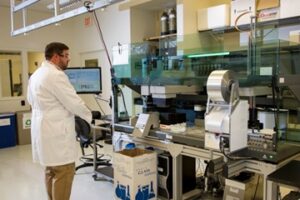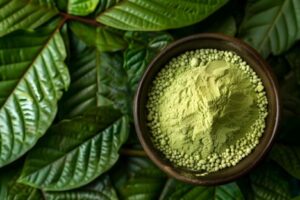
Among the emerging substances in contemporary research, Argireline, a hexapeptide with the sequence Acetyl Hexapeptide-3 (or Acetyl Hexapeptide-8), has garnered significant attention. This peptide, derived from a protein found in botulinum toxin, has been hypothesized to mimic its characteristics, potentially without requiring invasive procedures. As the scientific community delves deeper into understanding Argireline, its potential mechanisms and relevance in anti-aging research are becoming increasingly prominent.
Chemical Composition and Structure
Argireline is a synthetic peptide composed of six amino acids: glutamic acid, methionine, glutamine, arginine, and two residues of acetylated alanine. This specific arrangement is believed to allow the peptide to interact with the proteins involved in muscle contraction. The acetylation of alanine residues supports the peptide’s stability and penetration potential, making it a promising candidate for further study.
Mechanisms of Action
The primary mechanism proposed for Argireline involves its alleged impact on the SNARE (Soluble NSF Attachment Protein Receptor) complex. This complex is considered to play a crucial role in the release of neurotransmitters, which allow for localized muscle contraction. By interfering with the SNARE complex, Argireline is believed to inhibit the release of acetylcholine, a neurotransmitter that signals the contraction. Consequently, this inhibition might reduce the formation of wrinkles along the epidermis.
It has been theorized that Argireline might also influence collagen synthesis and skin elasticity. Collagen, a structural protein in the skin, decreases over time, leading wrinkle formation. By potentially promoting collagen production, Argireline might contribute to improved skin firmness and elasticity.
Argireline Peptide: Wrinkles
Argireline’s most researched action is its potential impact on wrinkle depth reduction. As the peptide might interfere with muscle contraction mechanisms, it may theoretically reduce the depth and length of dynamic wrinkles. Beyond wrinkle reduction, Argireline is suggested to have properties that may support the density and structure of skin cells, as well as elasticity.
Argireline Peptide: Moisturization and Skin Barrier Function
Some research indicates that Argireline might also support skin moisturization and barrier function. By retaining moisture and strengthening the skin barrier, the peptide might contribute to skin structures, making them more resilient to environmental stressors.
Comparative Analysis with Other Peptides
While Argireline is often compared to botulinum toxin due to its muscle-relaxing potential, it is essential to consider its position among other peptides studied in cellular research. For instance, Matrixyl (Palmitoyl Pentapeptide-4) is another peptide studied for its anti-aging characteristics, particularly its potential to stimulate collagen production. Unlike Argireline, which may primarily target muscle contraction, Matrixyl’s primary mechanism is thought to be collagen synthesis. This distinction highlights the unique properties of Argireline in comparison to other peptides.
Argireline Peptide: Formulations
Studies suggest that encapsulation techniques, such as liposomes or nanoparticles, might support the stability and penetration of the peptide, ensuring it reaches the target areas within the skin. Additionally, combining Argireline with other active ingredients, such as hyaluronic acid or vitamin C, may synergize their properties, leading to more comprehensive studies.
Argireline Peptide: Liposomal Exposure
Liposomes, spherical vesicles composed of phospholipids, may encapsulate active ingredients like Argireline, protecting them from degradation and enhancing their penetration through the skin barrier. Research indicates that this method may increase the peptide’s stability and bioavailability, maximizing its potential impact on skin cell aging.
Argireline Peptide: Nanoparticle Exposure
Investigations purport that nanoparticles may offer another advanced system for Argireline. These tiny particles may potentially penetrate the skin more effectively, ensuring that the peptide reaches deeper layers where it may exert its proposed impacts on muscle contraction and collagen synthesis.
Argireline Peptide: Future Directions and Research
As the understanding of Argireline expands, future research may focus on several key areas. First, long-term studies are needed to evaluate the sustained impacts of Argireline on cell aging and its potential cumulative properties. Additionally, exploring the synergistic impacts of Argireline with other peptides and active ingredients may lead to more practical studies. Moreover, advancements in exposure systems and formulation technologies might enhance the efficacy and stability of Argireline in compound development.
Conclusion
Findings imply that Argireline represents a promising frontier in cellular aging research. Its potential to modulate muscle contraction and influence collagen synthesis positions it as a versatile ingredient to explore in various scientific contexts. While more research is needed to fully understand and substantiate its properties, Argireline’s unique mechanisms offer exciting possibilities for developing innovative research studies. Visit Core Peptides for the best research peptides within the context of skin cell studies.
References
[i] Kluczyk A, Ludwiczak J, Modzel M, Kuczer M, Cebrat M, Biernat M, Bąchor R. Argireline: Needle-Free Botox as Analytical Challenge. Chem Biodivers. 2021 Mar;18(3):e2000992. doi: 10.1002/cbdv.202000992. Epub 2021 Feb 8. PMID: 33482052.
[ii] Henseler H. Investigating the effects of Argireline in a skin serum containing hyaluronic acids on skin surface wrinkles using the Visia® Complexion Analysis camera system for objective skin analysis. GMS Interdiscip Plast Reconstr Surg DGPW. 2023 Oct 31;12:Doc09. doi: 10.3205/iprs000179. PMID: 38024099; PMCID: PMC10665711.
[iii] Wang Y, Wang M, Xiao XS, Huo J, Zhang WD. The anti-wrinkle efficacy of Argireline. J Cosmet Laser Ther. 2013 Aug;15(4):237-41. doi: 10.3109/14764172.2013.769273. Epub 2013 Mar 6. PMID: 23464592.
[iv] Grosicki M, Latacz G, Szopa A, Cukier A, Kieć-Kononowicz K. The study of cellular cytotoxicity of argireline – an anti-aging peptide. Acta Biochim Pol. 2014;61(1):29-32. Epub 2014 Mar 17. PMID: 24644551.
[v] Velazco de Maldonado GJ, Suárez-Vega DV, Miller-Kobisher B, García-Guevara VJ. Polydioxanone Bioactive Sutures-Acetyl Hexapeptide-8 (Argireline): An Intelligent System for Controlled Release in Facial Harmonization. J Cutan Aesthet Surg. 2023 Oct-Dec;16(4):325-334. doi: 10.4103/JCAS.JCAS_34_23. PMID: 38314369; PMCID: PMC10833482.







